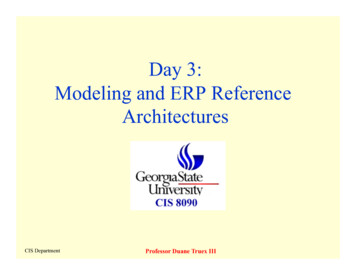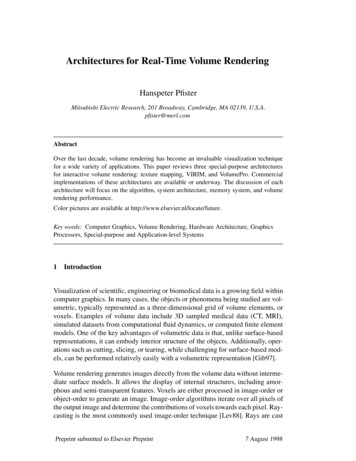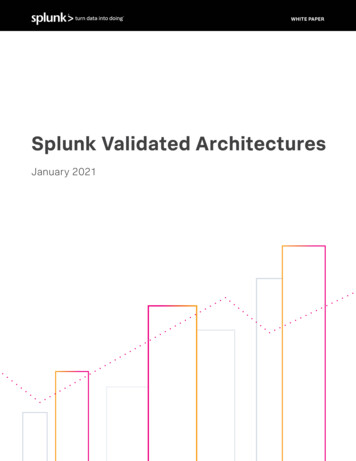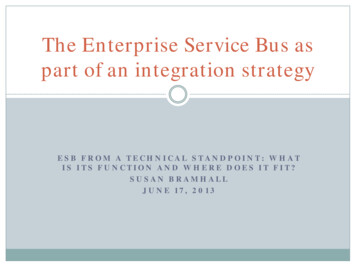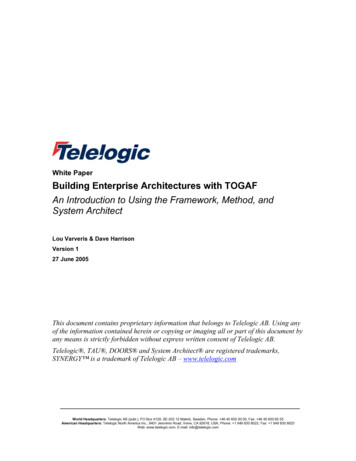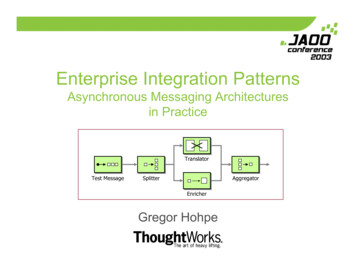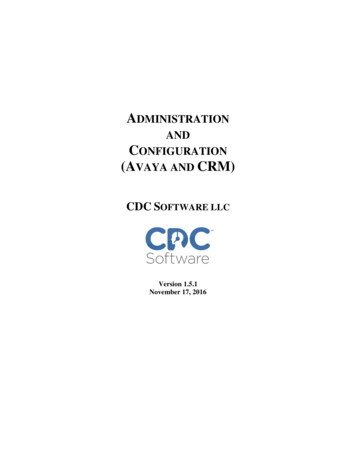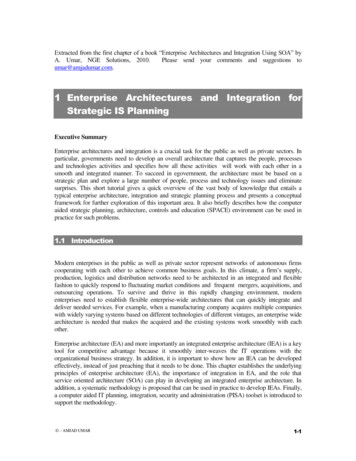
Transcription
Extracted from the first chapter of a book “Enterprise Architectures and Integration Using SOA” byA. Umar, NGE Solutions, 2010.Please send your comments and suggestions toumar@amjadumar.com.1 Enterprise Architectures and Integration forStrategic IS PlanningExecutive SummaryEnterprise architectures and integration is a crucial task for the public as well as private sectors. Inparticular, governments need to develop an overall architecture that captures the people, processesand technologies activities and specifies how all these activities will work with each other in asmooth and integrated manner. To succeed in egovernment, the architecture must be based on astrategic plan and explore a large number of people, process and technology issues and eliminatesurprises. This short tutorial gives a quick overview of the vast body of knowledge that entails atypical enterprise architecture, integration and strategic planning process and presents a conceptualframework for further exploration of this important area. It also briefly describes how the computeraided strategic planning, architecture, controls and education (SPACE) environment can be used inpractice for such problems.1.1 IntroductionModern enterprises in the public as well as private sector represent networks of autonomous firmscooperating with each other to achieve common business goals. In this climate, a firm’s supply,production, logistics and distribution networks need to be architected in an integrated and flexiblefashion to quickly respond to fluctuating market conditions and frequent mergers, acquisitions, andoutsourcing operations. To survive and thrive in this rapidly changing environment, modernenterprises need to establish flexible enterprise-wide architectures that can quickly integrate anddeliver needed services. For example, when a manufacturing company acquires multiple companieswith widely varying systems based on different technologies of different vintages, an enterprise widearchitecture is needed that makes the acquired and the existing systems work smoothly with eachother.Enterprise architecture (EA) and more importantly an integrated enterprise architecture (IEA) is a keytool for competitive advantage because it smoothly inter-weaves the IT operations with theorganizational business strategy. In addition, it is important to show how an IEA can be developedeffectively, instead of just preaching that it needs to be done. This chapter establishes the underlyingprinciples of enterprise architecture (EA), the importance of integration in EA, and the role thatservice oriented architecture (SOA) can play in developing an integrated enterprise architecture. Inaddition, a systematic methodology is proposed that can be used in practice to develop IEAs. Finally,a computer aided IT planning, integration, security and administration (PISA) toolset is introduced tosupport the methodology. – AMJAD UMAR1-1
CHAPTER 1: ENTERPRISE ARCHITECTURES AND INTEGRATION -- THE BIG PICTURETo better understand the complex interactions between business and IT and how IT supports thebusiness, a very simple view is presented in Figure 1-1. This view of an enterprise is presented interms of three high level layers and their role as drivers and enablers of an enterprise: Business focused layer that concentrates on business strategies, services and business processes: Business plus technology focused layer that deals with enterprise business applications Technology focused layer that provides the IT (information technology) infrastructureBusiness strategies represent the long range game plan to win in the marketplace. Business strategiesalign the business products/services, processes, and several other activities to survive and succeed inthe marketplace. The term business service and business process are frequently interchanged. For thepurpose of this book, we will use the following definitions; Business service (BS) is something that is delivered to the customer. For example, dry cleaningservice, house renovation service and online banking represent things that are delivered to thecustomer, usually for a fee. A business service may be delivered to internal or external customers.For example, a payroll service is delivered to the employees of a company. Businesses usuallydeliver products, services or both to its customers. Business process (BP) is a collection of activities that are required to achieve a business goal –the goal may be a business service. At a basic level, a BP can be represented as a flowchart thatspecifies the orchestration of activities needed to complete the goal. For example, for a payrollservice, several BPs have to be carried out (e.g., pay has to be computed, deductions have to beconsidered, overtime may need to be calculated, etc).Figure 1-1: Key Components of an EnterpriseAs we will see, the simple but elegant view presented in Figure 1-1 will lead us to the followingstarter definition of an Enterprise Architectures:Enterprise architecture (EA) Business architecture application architecture technology architecture (computer platform architecture network architecture) Key ConceptsBusiness strategies, applications, and IT infrastructure are the three essential components of anenterpriseAn enterprise architecture (EA) shows components of an enterprise, what do they do, and how dothey interface/interact with each otherEnterprise architecture (EA) Business architecture application architecture technologyarchitecture (computer platform architecture network architecture)1-2
Integrated enterprise architecture (IEA) EA with focus on integration. Integrated enterprisearchitecture provides an inventory of the business and IT resources and how they work with eachother smoothly and seamlessly (hopefully!).IEA promises many benefits that include: identifying what resources exist; improving integrationamong resources; facilitating business process improvement, and creating speed and efficiency inmeeting changing business needs through IT.SOA is an effective way to develop an IEA. SOA provides a standards-based conceptualframework for flexible and adaptable enterprise wide systems.A high level methodology is very useful in developing an IEA. The methodology presented in thischapter consists pf individual plans that can be developed and then integrated together into anenterprise wide architecture.1.2 Enterprise Architecture and Integration Concepts1.2.1 What is an Architecture?Architectures play a vital role in modern information systems because they show how the individualsystems tie together to satisfy the overall requirements. Many views on architectures exist at present(see, for example, [Askit 2001, Caruso & Umar 2003, Clemens 2002, Herzum 2000]). It is not ourobjective to give a comprehensive discussion and comparison of architecture definitions (see thesidebar "Architectures: Glossary and Definitions"). Instead, we adopt the following simple but highlyoperational definition of architecture:Definition: An architecture of a system is a structure that describes three things: Components of the system (what are the pieces of a system?), Functions performed by the components (what do they do?), and Interfaces/interactions between the components (how do they work with each other?).This definition is consistent with the IEEE 610.2 definition of an architecture: "The structure of thecomponents, their properties, relationships, and the principles and guidelines governing their designand evolution over time."Within the context of information systems, several types of architectures have emerged over the years(e.g., business architectures, database architectures, computing architectures, network architecturesand software architectures). In all of these cases, it is useful to remember what are the components ofthe system, what they do, and how they interface/interact with each other. For example, a businessarchitecture would show the business components (e.g., the business processes), what they do (e.g.,satisfy customer needs) and how they interface/interact with each other.Architectures: Glossary and Definitions – AMJAD UMAR1-3
CHAPTER 1: ENTERPRISE ARCHITECTURES AND INTEGRATION -- THE BIG PICTUREBuilding Construction Architectures: The structural abstractions (e.g., blueprint) and styles (familiesof related common variations) that define a class of structure (e.g., a cathedral) or a particular structure(e.g., my house). Architecture usually focuses on the big picture and not the details of what color myrug is or specific pictures on my wall, though such details can be viewed as architectural since theycould be consonant or dissonant with the architecture's theme. There is no clear dividing line.Application Architectures: Application architectures are broad architectures of thedomain/application of interest and, more narrowly, sometimes application generators for specificdomains.Software Architecture: A static framework or skeleton (structure or set of conventions) that providesthe form of a software system and the conventions, policies, and mechanisms for composing itself withsubsystems, or component parts, that can populate the architecture. The architecture defines how theparts relate to each other including constraints governing how they can relate. An abstract framework isone that has not been instantiated with specific subsystems.Other Glossaries: Gio Wiederhold's glossary of I3 architecture terms (www-db.stanford.edu/gio/1996/glossary.ps). DoD DISA terminology (www.disa.mil/disasub.html). NIIIP Reference Architecture: Concepts and Guidelines - Glossary .html).Source: Craig Thompson and Frank Manola, "Component Software Glossary", www.objs.com,Glossary sponsored by the Defense Advanced Research Projects Agency and managed by the U.S.Army Research Laboratory under contract DAAL01-95-C-0112. 19971.2.2 What is an Enterprise Architecture and Why is it Important? 1An enterprise architecture (EA), based on the aforementioned definition of an architecture, showscomponents of an enterprise, what do they do, and how do they interface/interact with each other.Basically, an EA is a consolidation of business and technology that can be of great value to thecorporate management as well as CIOs. Here are some possible values of EA [Cardwell 2008, Koch2005, Rico 2006]: EA aligns IT to business and leads to integration of business and technical processes. Basically,an EA is a road map that presents how all aspects of the IT program are aligned with theorganization’s strategic goals. Properly executed, “an EA can clarify and help optimize the interdependencies and relationshipamong an organization’s business operations and the underlying IT infrastructure andapplications that support these operations” [Cardwell 2008, pp.49].This discussion has been greatly influenced by the research paper “Enterprise Architecture Leads to IT ROI and Competitive Advantage” byJennifer Gronwaldt, Pennsylvania State University- Harrisburg, December 8 200811-4
EA facilitates the CIO’s performance and supports the deliverables by the CIO and the ITorganization. It provides an explanation of how IT is used to enable the business processes andbusiness strategies.Review of EA documents can reveal gaps and duplication and can also support impact analysis.EAs facilitate enterprise planning and problem solving views at different layers (business,applications, and IT infrastructure).EAs can be used to document the present method of operation (PMO) as well as the futuremethod of operation (FMO). The differences between PMO and FMO lead to gap analysis and aplanning tool about how to ‘get from here to there’.EA can be used to evaluate the quality of IT services. return on investment (ROI) from IT can bederived by uncovering where, how well, and for what end IT is being used.The process of developing the EA creates opportunities for continuous business processimprovement. An EA is developed in a similar manner to how a business process hierarchy isdeveloped, as both are a visualized understanding of the relationship between people, process,information and technology. In some cases, the careful examination of business processesrequired in developing the EA, leads to the instances when some of the business processes areactually written down.Development of an EA presents an opportunity for collaboration between IT and other businessfunctions. It also requires support from the top management -- investment of time and resourcesplus commitment to the changes inherent to the discoveries resulting from the EA process have tobe authorized. An ideal EA initiative can emerge from the joint support of the CIO and CEO, orother chief operations or financial officers.Figure 1-2: Conceptual View of an Enterprise Architecture and its BenefitsFigure 1-2 shows a conceptual view of an EA and its benefits in terms of four broad categories(planning, integration, security, and administration – PISA). This conceptual view is the foundationof the PISA toolset described later. EAs, however, present many challenges to the organization.Development and maintenance of an EA can be a long and expensive undertaking. It is important tomeasure ROI of an EA effort. For ROI estimates, tangible measurements of the costs and benefitsneed to be identified. The costs of establishing an EA can be organized into distinct classes such asfinancial improvement, constituent services, and reduced redundancy. The benefits have been listedabove. Monetizing the different types of costs and benefits facilitates the demonstration of ROI.Besides ROI, considerable effort is needed to make sure that the EA efforts are successful. Forexample, CIOs and CTOs can be removed from the actual development and the use of the EAdocument, especially in large organizations. In such cases, a group of architects, each focusing on adifferent dimension, generally report to a chief enterprise architect, who in turn, reports to the CIO – AMJAD UMAR1-5
CHAPTER 1: ENTERPRISE ARCHITECTURES AND INTEGRATION -- THE BIG PICTUREA great deal of information about enterprise architectures is available. Here are some key sources: The Open Group Website (http://www.opengroup.org) Zachman Institute for Framework Architecture (ZIFA) Website: (www.ZIFA.com) :: EA Portal at www.enterprise-architecture.info Enterprise Architecture Center of Excellence (EACOE) website (http://eacoe.org) Gartner Group (www.gartner.org) Enterprise Architecture PracticeCase Study: FDA Uses Enterprise Architecture to Standardize and SaveThe Food and Drug Administration (FDA) needed to develop a plan for consolidation of its ITinfrastructure across eight division centers and identify standard software applications to be utilizedfor common business needs. The FDA turned to Enterprise Architecture (EA) to serve as themethodology to achieve its desired state of efficiency and effectiveness. FDA maximized itsinfrastructure by replacing single-use environments with platforms shared across application systemboundaries and consolidated IT operations from multiple buildings to two major locations byemploying homogenous platform architecture.EA driven IT consolidation has allowed the FDA to use fewer resources while operating moreefficiently and providing better services. Key benefits of this project include: increased cost savings(over 10 million redundant IT related costs eliminated), documented and standardized businessprocesses (over 85% of agency-wide processes are now documented), consolidation of ITinfrastructure resulting in less applications (for example the number of correspondence trackingsystems were reduced from 24 to 2), improved communication, and lastly improved ov/documents/FDA FINAL.pdfOffice,Link:Benefits of Enterprise Architectures – Views of a CTOIn a 2004 article for the Zachman Institute for Framework Advancement (ZIFA), General MotorsCTO Tony Brown, lists the reasons below as what he considers to be the top advantages ofimplementing EA: Readily available documentation of the enterprise Ability to unify and integrate business process across the enterprise Ability to unify and integrate data across the enterprise and to link with external partners Increased agility by lowering the ‘complexity barrier’ Reduced solution delivery time and development costs by maximizing reuse of enterprisemodels Ability to create and maintain a common vision of the future by both the business and ITcommunities driving continuous business/IT alignmentSource: [Cardwell 2006]1-6
1.2.3 From Enterprise Architectures to Enterprise IntegrationDevelopment and maintenance of an EA, as suggested so far, is a worthwhile effort. However, howdoes it impact enterprise integration – an area of particular interest in the competitive marketplace.Most organizations are struggling to integrate their systems to maintain a competitive edge. The drivefor enterprise wide integration is not new. Mergers and acquisitions, for example, introduce numerousscenarios when systems from one company need to mesh with the systems of the new corporate"friends". However, as the enterprises move towards the outer edges of the enterprise model shownpreviously in Error! Reference source not found., the lack of integration matters more. Forexample, the threat of losing customers to competitors who can service their customers faster andcheaper because their order processing system is nicely integrated with payment and shipping systemis real. To survive in the fiercely competitive market, several companies have embarked onstreamlining initiatives to cut product development time and to reduce product delivery time. Toachieve this, enterprise-wide integrated systems such as the following are needed (see [Kalakotta2002a, Carter 2007] for numerous examples and case studies): Procurement systems that link order processing with payment, inventory management andshipping Manufacturing systems that link suppliers, designers, product managers, and production plannersin a uniform manner. Customer support systems that link customer service with customer relationship management,marketing and sales. Health information networks that link various hospitals, doctors, pharmacies and healthinsurance providers Supply chain management systems that link several suppliers with the material requirementplanning (MRP) systems of consumersTwo sidebars (“Case Study: Bharti Airtel Enterprise Architecture Framework” and “Case Study:Bombardier Aerospace Adopts Flexibility”) illustrate flexible enterprise architectures in practice.How can an EA help in enterprise integration efforts? Enterprise integration means makingindependently designed enterprise systems work together. For enterprise integration, the goal is toprovide standardized high-quality customer service across the entire firm’s service channels. Multichannel integration is critical because customers expect consistent service when they interact with acompany, no matter which channel they use. Multi-channel integration is also a critical issue for anybusiness striving to maintain its competitive advantage [Kalakota 2002a]. As we will see later, mostdefinitions of enterprise integration touch on similar if not common concepts related to workingtogether, sharing, interacting, and collaborating. Naturally, a well-documented EA with clearlyspecified interfaces and interactions between various business and technical components, provides thebasis for well integrated systems.Enterprise integration can be at several layers (e.g., business process integration, applicationintegration, platform integration). However, enterprise application integration (EAI) receives most ofthe attention due to the following main reasons: Lack of integration between enterprise applications is very visible to the customers and businesspartners. For example, if an order processing system is not integrated with a payment system,then the customer has to place an order on one system and then go back and pay by using atotally different system – possibly having to re-enter all information again. Many of the enterprise applications can be "legacy" applications that are old, unstructured, andmonolithic. According to Webster, “legacy is something of value that is passed along to the nextgeneration”. Dealing with legacy applications has been a dominant concern of IT management – AMJAD UMAR1-7
CHAPTER 1: ENTERPRISE ARCHITECTURES AND INTEGRATION -- THE BIG PICTUREfor many years. If possible, the IT management would like to keep the legacy systems intactbecause they provide vital services (e.g., billing) that are very risky to disrupt. However,something must be done about these systems because these systems are inflexible and arebecoming increasingly expensive to maintain especially in the modern enterprise scenarios.Example: Developing Architecture of a City – Lessons for IS ArchitectsDevelopment of integrated architectures for enterprise applications that span organizational units andenterprises is similar to establishing design of a city for an ever-changing and ever-evolvingindustrial and residential population. We have to worry more about how the individual parts of thecity will be known to the city dwellers and how will they be interconnected (i.e., the infrastructureneeded), instead of how the individual buildings will be designed internally. We only establishpolicies, rules and guidelines for the building externals and focus more attention to the bigger issuesof access and flows between the buildings (i.e., all buildings must be accessible). In a similar vein,integrated architectures of enterprise applications is like designing many mini applications that needto interact with each other for corporate business goals. The emphasis is on identifying the interfacesof the applications, and the infrastructure needed to make this application operable as an enterprisewide as well as, if needed, inter-enterprise application.1.2.4 Enterprise Architectures and Integration – A Closer LookAs stated previously, an enterprise architecture describes the enterprise building blocks (the businesslayer, the application layer, and the technology infrastructure layer), what they do and how do theyinterface/interact with each other. Let us use Figure 1-3 for a closer look at enterprise architectures.This figure shows a more detailed view of the enterprise building blocks (business processes neededfor the business, enterprise applications that automate the business processes, computing platformsand middleware services that support the applications, and the network services that interconnect thevarious platforms in an enterprise). These building blocks are represented as horizontal layers –higher level layers are more business oriented and lower level layers are more technology oriented.Different types of architectures at different layers can be envisioned as shown in the vertical bar ofFigure 1-3. For example, business architecture represents the architecture at business process layer,enterprise application architecture represents architecture at application layer, etc. Thus an enterprisearchitecture represents all the architectures at all layers of an enterprise, i.e., it is the vertical bar inFigure 1-3. Based on this, we can introduce the following definitions of enterprise architectures:Definition 1. Enterprise Architecture architecture of architectures.Definition 2. Enterprise Architecture Business Architecture Application Architecture Computing Platform Architecture Network Architecture1-8
EnterpriseArchitectureBuilding BlocksHealthcare BPs(Clinical)Business ProcessesOther Vertical BPsTelecom BPs(MRP, Financial)(e.g. Provisioning)BusinessArchitectureCommon BPs (Marketingt, CRM, HR)Enterprise ApplicationsVertical IntegrationsHealthcare(HCIS)Telecom OSSsOther Vertical AppsApplicationArchitectureCommon Apps: (ERPs for CRM, HR, etc)Platform and Middleware ServicesSpecialized Services (EC,B2B, )Mobile Platforms(WAP, J2ME, BREW,)PlatformArchitectureCommon Middleware (Web, Web 2.0, Web services ,)Network Services (Layer 1-4 of OSI)Wired Networks(LANs, MANs,WANs)Wireless NetworksNGNs(5G Cellular, WLANs,(ConvergedWPANs, WLLs,Networks)Satelites, MANETs)NetworkArchitectureHorizontal IntegrationFigure 1-3: Building Blocks of Enterprise Architecture and IntegrationLet us now include the integration consideration. The objective of an integrated enterprisearchitecture is to show how well all the business plus technical components work together to serve theenterprise needs. Development of an integrated enterprise architecture, referred to as integratedarchitecture in this book for simplicity, generally starts with documenting the organization's strategyand goals. The integration process concentrates on the interactions and the interfaces between theenterprise structural components, at the following layers shown in Figure 1-3: Business architecture that basically describes the business processes and how theyinteract/interface with each other. Application architecture that shows the various application software packages and how theyinteract/interface with each other through messages and data flows. This may include aninformation model that shows how the information flows between various software components. Computing platform architecture with interactions and interdependencies between differentoperating systems, system software packages and middleware services located on variousdesktops, servers, and mainframes. Network architecture with Intranet, Extranet, Public Internet and network devices interconnectedthrough various connectivity devices and gateways.An EA diagram such as Figure 1-3 serves as a very effective framework for enterprise wideintegration -- facilitating vertical as well as horizontal integrations: Vertical integrations show a business architecture that is integrated with technology architecture(enterprise applications, platforms and networks) of a company or a division of a company. Itcombines business, applications and IT infrastructure components into a solution for a particularsituation (typically known as a “silo”). An example of vertical integration is a supply chainmanagement ERP system that automates all supply chain processes and operates on Linuxplatforms. Horizontal integrations show how processes and technologies at the same layer are integrated.For example, the integration of business processes in sales with business processes in supplychain represent a horizontal integration at business process level. Similarly, enterprise applicationintegration represents how different ERPs within an organization seamlessly work each other and – AMJAD UMAR1-9
CHAPTER 1: ENTERPRISE ARCHITECTURES AND INTEGRATION -- THE BIG PICTURE inter-enterprise (B2B) application integration architectures represent supply chain managementapplication integration across multiple enterprises. As another example, smooth transitionbetween wired and wireless networks (e.g., roaming support between a cellular phone, a Wi-FiLAN and a wired corporate Intranet) represents a horizontal network integration.Mixtures represent an integrated architecture that is a combination of vertical architectures thatinterconnect different layers as well as the horizontal architectures at the same layers of anenterprise. In many practical cases, mergers and acquisitions lead to these integration scenariosbecause many organizations have vertically integrated systems but when two or moreorganizations merge, multiple vertical architectures need to be integrated horizontally – a realheadache. This is known as the “information silo” problem, as mentioned in the BombardierAerospace case study previously.Based on this discussion, we can introduce the following definitions of integrated enterprisearchitectures:Definition 3. Integrated Enterprise Architecture Horizontally Integrated EnterpriseArchitecture Vertically Integrated Enterprise ArchitectureDefinition 4. Integrated Enterprise Architecture Enterprise Architecture IntegrationTechnologies (for vertical plus horizontal integrations)Sayings About Good Architectures“We shape our buildings and afterwards our buildings shape us” -- Winston Churchill“While any single product is apt to become quickly outdated, a well-designed and open-endedarchitecture can evolve along with critical technologies, providing a fixed point of stability forcustomers and serving as the platform for a radiating and long-lived product family” -- C. Morrisand C. Ferguson, “How Architecture Wins Technology Wars”, HBR, March-April 19931.2.5 An Example – Frank’s Furniture Store (FFS)21.2.5.1 Example OverviewWe will use Frank's Furniture Store, New York City (NYC), as an example to illustrate the key pointsin the balance of this chapter. FFS is a small store with big ideas. Frank started selling kitchen andbedroom furniture 5 years ago and wants to expand aggressively in the next 3 years. He currently has80 employees in NYC and is partnering with a mover to deliver the items. His plans are:1. Next year he wants to acquire a small manufacturing shop so that he could design, build, sell,and repair custom built furniture. He also wants to open five furniture outlets, in different partsof the country, to sell his furniture. He expects to double the size of his company next year.2. In two years, Frank wants to diversify into a wide range of other products (e.g., living room andoffice furniture, paintings). He also wants to start partnering with other retail stores andmanufacturers. The parts and components will be brought from suppliers located overseas to hismanufacturing site.2This example is based on a real life retail store.1-10
Frank is a good businessman but is not very technical. He keeps track of all information on a MSWord file and also uses an MS Excel sp
Enterprise architecture (EA) and more importantly an integrated enterprise architecture (IEA) is a key tool for competitive advantage because it smoothly inter-weaves the IT operations with the organizational business strategy. In addition, it is important to show how an IEA can be developed

